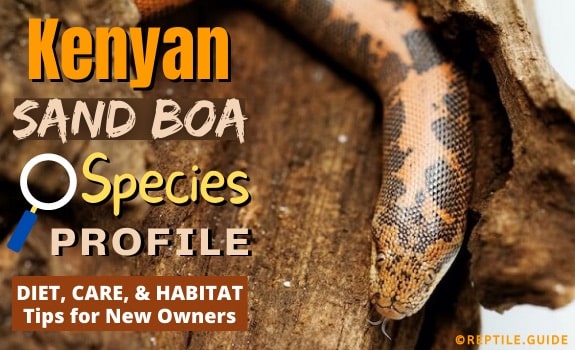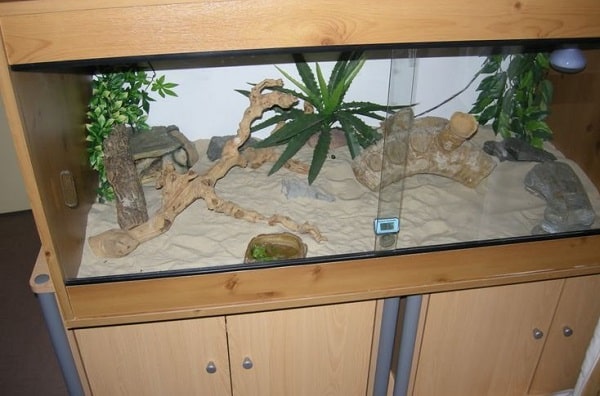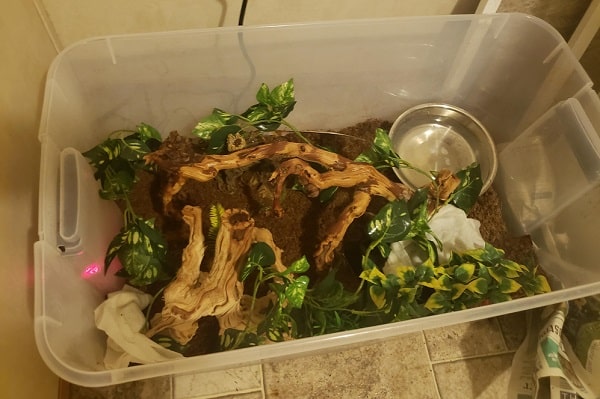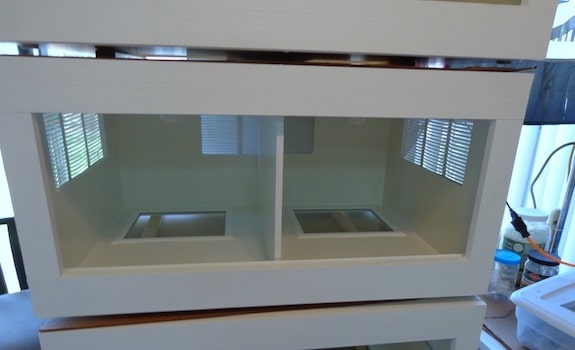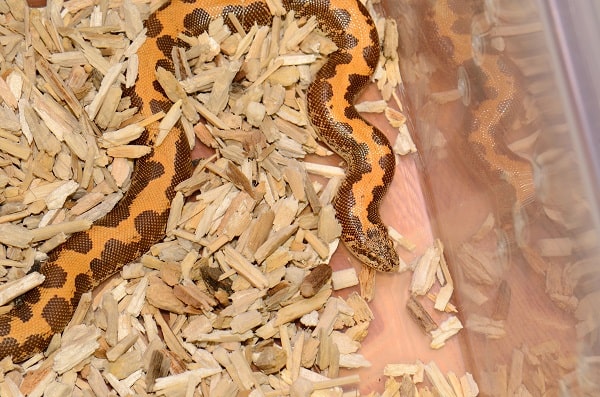The Kenyan Sand Boa (KSB for short) has been increasing in popularity among exotic pet owners and for good reasons.
You see, very few species can rival the favorable characteristics of KSB’s. Of these favorable characteristics, their manageable size, simple care requirements, and docile temperament all help to cement them as one of the best pet snakes to own.
If you’re trying to decide if the Kenyan Sand Boa is the right type of snake for YOU, you’ve come to the right place.
Stick around and get the complete low-down on everything there is to know about the Kenyan Sand Boa their diet, size, lifespan, habitat setup, and much, much more!
In This Article
Kenyan Sand Boa Background Information
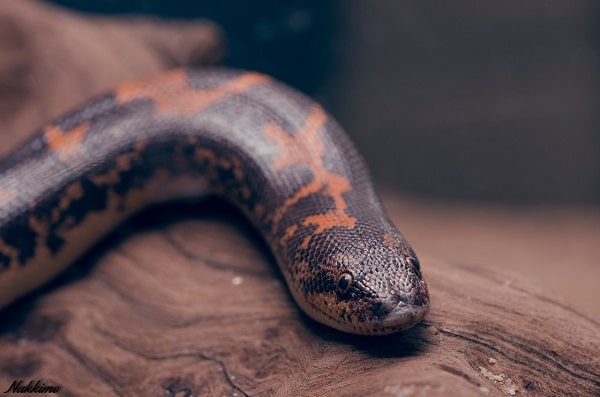
Kenyan Sand Boas (Gongylophis colubrinus) are small snakes in the Boidae family. They’re also known as the KSB or the Egyptian Sand Boa.
As their name suggests, Kenyan Sand Boas are native to the sandy deserts and savannahs of Northern and Eastern Africa.
Like many snakes, Kenyan Sand Boas are sexually dimorphic, with females typically growing twice as large as males.
| Length | Weight | |
| Male KSB’s | 15-24″ | 70-100 grams |
| Female KSB’s | 24-36″ | 400-900+ grams |
Kenyan Sand Boas tend to be hardy and healthy animals, which is why they’re such great pets for novice snake keepers.
There are numerous reports of well cared for Kenyan Sand Boas living over 30 years in captivity.
The small size, simple care requirements, and easy-going demeanor of most Kenyan Sand Boas make them perfect reptilian pets for beginners and experts.
Wild-type KSBs are orange or yellow with large, dark brown or black splotches. Their bellies are off-white.
Thanks to buyer interest and the sheer numbers that are produced in captivity, several different color and pattern mutations have cropped up, including:
- Anerythristic (lack of red/orange pigment)
- Amelanistic or Albino (lack of black pigment)
- Striped
- Hypomelanistic (low amount of black pigment)
- Paradox (patches of pigment that should not otherwise be present)
- Splash (lack of pattern, or aberrant pattern, on the tail end)
- Paint (white stripe down back with standard splotched sides)
- Any combination of the above!
| Facts at a Glance: | |
|---|---|
| Common name | Kenyan Sand Boa |
| Scientific name | Gongylophis colubrinus |
| Adult size | 15-36 inches |
| Price | $70 to $130 |
| Lifespan | 30 years |
| Diet | Mice & other rodents |
| Tank Size | 30” L x 12” W x 12” H (20 gallons) |
| Temperature & Humidity | Warm side: 90-95°F & Cool side: 70-75°F, Humidity: 30-50% |
| Popular alternatives | Western Hognose, Rosy Boa, Ball Python |
Where to Buy a Kenyan Sand Boa
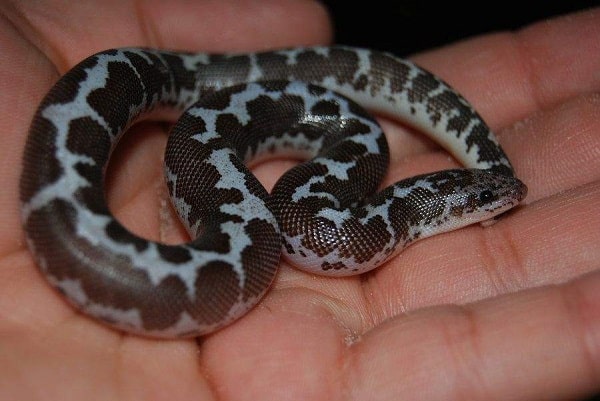
Kenyan Sand Boas are common in captivity.
You can usually find a Kenyan Sand Boa for sale at any from any of the following:
- Reputable breeder online
- Local reptile or exotic pet specialty shop
- A reptile expo
- Online reptile classifieds
While this species is not as common as ball pythons or corn snakes, you may also have luck finding one to adopt from a reptile or exotic pet rescue organization.
Kenyan Sand Boa Diet & Feeding
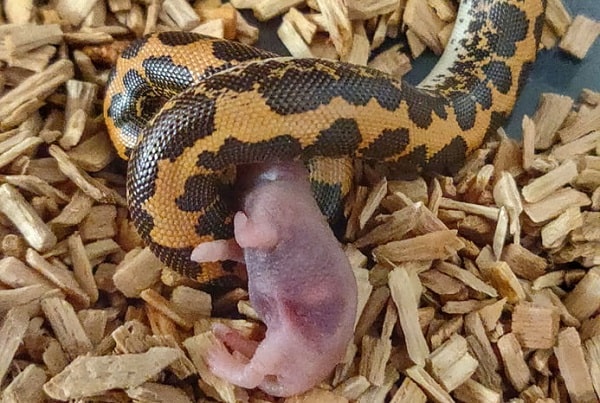
Like most snakes that are common as pets, Kenyan Sand Boas thrive on a diet consisting exclusively of frozen and thawed mice.
Frozen mice can be thawed by placing them in a plastic bag and placing the plastic bag in a bowl of hot (not boiling) water for 20 to 30 minutes.
Never microwave, boil, or otherwise cook frozen mice for snakes.
If you feed your Kenyan Sand Boa in its enclosure, ensure no substrate is ingested with the prey.
Ingested substrate can cause an impaction, which is usually fatal if not treated.
It’s safer to feed your pet in a snake bag or a ventilated, bare-bottomed, plastic container.
Don’t handle your Kenyan Sand Boa for 24-48 hours after it eats.
Most KSBs are voracious eaters, but a stubborn few may resist frozen/thawed prey or go on a hunger strike due to:
- Seasonal changes
- Improper enclosure temperature
- Improper enclosure humidity
- Stress
- Shedding
Try researching these harmless feeding techniques that are often used to encourage stubborn snakes to eat:
- Braining
- Scenting
- Wiggling
- Private feeding
- Different color, size, or species of prey
Prey Size & Feeding Schedule
The size of the mouse and how often you will feed your Kenyan Sand Boa depends mostly on its age.
The general rule of thumb for prey size is to feed something as wide as the thickest part of your snake’s body.
| Kenyan Sand Boa Feeding Schedule | |
|---|---|
| 0-12 Months Old: | Appropriately sized meal every 5-7 days. |
| 12+ Months Old: | Appropriately sized meal every 7-28 days. |
Feeding BABY Kenyan Sand Boas
Neonate KSBs are capable of eating pinkie mice after their first shed.
As they grow, increase the prey’s size to equal the widest part of your snake’s body.
🤓 Expert Tip: The earlier you begin feeding your Kenyan Sand Boa frozen and thawed (F/T) prey, the more likely they are to accept it.
Some babies may only accept live pinkies for the first few feedings.
It’s easy to transition them by offering a fresh pre-killed mouse immediately after they eat a live mouse.
The next feeding, offer a fresh pre-killed mouse first, and as soon as they finish eating it, provide a F/T mouse.
Feeding ADULT Kenyan Sand Boas
Like most snakes, adult Kenyan Sand Boas have a slow metabolism, and they don’t need to digest food constantly.
Decreased food availability decreases fat stores and encourages exercise and muscle development, which will help your Kenyan Sand Boa live a long, healthy life.
As they grow, increase the prey’s size to equal the widest part of your snake’s body.
🤓 Expert Tip: If you can see the skin stretched between your Kenyan Sand Boa’s scales, it is overweight, and you should cut back on the size or frequency of feedings.
Adult male KSBs will eat fuzzy mice, while adult female KSBs will eat adult mice.
Breeding animals require more food to maintain good body condition.
Kenyan Sand Boa Habitat & Tank Setup
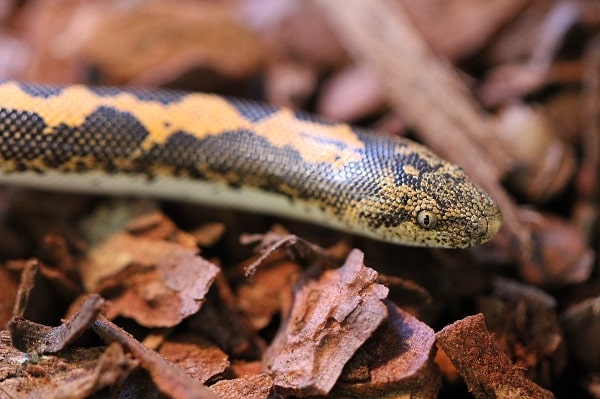
While you may not always see them exploring, attentive keepers have noted that this can be an active species that displays fossorial behavior. As such, Kenyan Sand Boas enjoy having space to burrow and tunnel within the substrate.
They’re perfectly suited for life under and above ground, and at night they often come out of the substrate to hunt and even climb low-lying enclosure decorations.
Size of the Enclosure
Minimum Dimensions: 30” L x 12” W x 12” H
This is roughly the equivalent of a 20-gallon long aquarium.
You may want to consider giving huge females more space, while some smaller males could make do with slightly less space.
🤓 Expert Tip: If you utilize terrarium decor to make the habitat feel “cluttered,” like their habitat in the wild, your Kenyan Sand Boa will use all of the space that you can afford to give them.
As they grow, increase the prey’s size to equal the widest part of your snake’s body.
They may become stressed in large enclosures that have too much open space.
Type of Enclosures
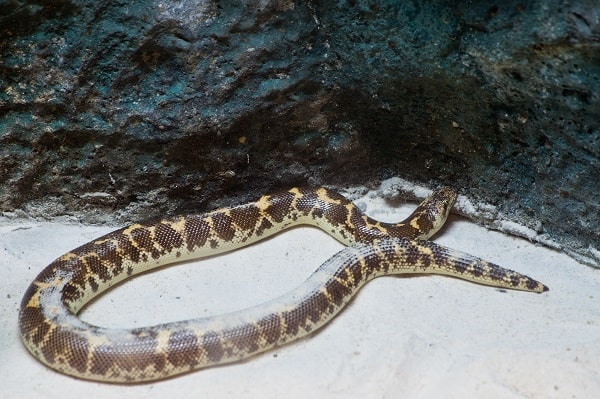
Since Kenyan Sand Boas don’t have exceptionally high or low temperature or humidity requirements, they can be comfortably housed in most common snake enclosure options.
1. Glass or Acrylic Aquarium
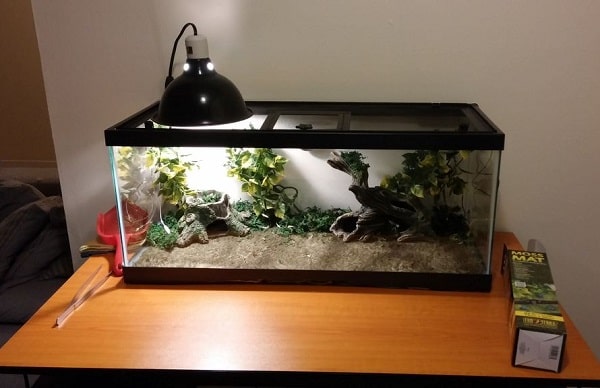
The glass or acrylic aquarium is the common choice for small pet snakes, including Kenyan Sand Boas.
These types of enclosures are readily available at:
- Pet stores
- Supermarkets with a pet department
- Second-hand stores
- Garage sales
Be sure to use clips to secure the screen lid to the top of the enclosure to prevent escapes.
A reptile heating pad, heat lamp, or heat tape are viable options for heating an aquarium habitat.
2. Front Opening Terrariums
Front-opening terrariums tend to be a tad more expensive and harder to find than aquariums, but they may be worth it.
When you reach into a snake’s enclosure from the top, it usually views you as a predator swooping in from above. This can increase stress, nervousness, and defensive behaviors in any snake, including Kenyan Sand Boas.
Front opening terrariums allow you to reach in from the front. so it’s less scary for your snake and more comfortable for you.
Front-opening enclosures also offer much more freedom and space in terms of maneuvering decorations and cleaning hard to reach places.
A reptile heating pad, heat lamp, or heat tape are viable options for heating a glass or acrylic terrarium.
3. Plastic Tub
Plastic tubs offer an economical way to house your Kenyan Sand Boa.
Depending on how many snakes you own, you may opt for a rack or shelf of tubs or a standalone tub.
In addition to being incredibly affordable, most tubs offer your snake more of a visual barrier to the outside world and, in turn, a sense of security.
Kenyan Sand Boas do perfectly fine in shallow tubs, like the styles used in racks, since they mostly prefer to burrow.
However, if you’re able to house your KSB in a tub that is at least 12″ tall, they will undoubtedly appreciate and utilize the extra space to climb and explore as well.
Most racks are heated with heat tape.
A standalone tub may be heated with heat tape, a reptile heating pad, or the lid can be modified with a screen to accommodate a heat lamp.
4. PVC or Wood Enclosure
PVC and wood enclosures offer the benefits of a front-opening enclosure and solid sides that will help your snake feel less exposed.
They’re also great for retaining heat and, although not necessary with Kenyan Sand Boas, humidity.
There are many online, commercial manufacturers of wood and PVC snake cages, or you could try building your own if you are handy.
Wood enclosures are much heavier than PVC enclosures.
These customized snake habitats tend to be cost-prohibitive compared to other standard options, but they’re stackable and offer a clean, professional appearance.
Wooden and PVC enclosures may be heated with a radiant heating panel or a heat lamp.
The heat from a heating pad or heat tape won’t be able to penetrate the bottom of the enclosure, but some keepers have devised ways to keep these elements safe on the bottom of the inside of the cage with the use of tile, glass, and silicone.
Temperature Gradient
| Warm Side Temperature: | 90-95°F |
| Cool Side Temperature: | 70-75°F |
Like most reptiles, Kenyan Sand Boas use the temperature of their environment to regulate their internal body temperature.
This is called thermoregulation, and cold-blooded animals that need to thermoregulate are called ectothermic.
To achieve the temperature gradient specified above, use one or two heating elements on one side of the enclosure, and allow the other side to drop to room temperature.
The heating element should cover no more than ½ of the enclosure, but preferably closer to ⅓ of it.
Generally speaking, Kenyan Sand Boas will stay near the warm end when they’re digesting food, or they’re gravid, and they’ll stay near the cool end when they’re fasting or shedding.
The increased humidity level on the cool end of their enclosure helps them shed their skin.
Humidity Levels
Ideal Humidity: 30-50%
It’s recommended to keep a humid hide in your Kenyan Sand Boa’s enclosure, especially if you notice it’s going into shed.
Even though these animals are known for living in arid semi-desert environments, they inhabit soil and leaf litter, which is usually quite moist.
Because of this discrepancy, stuck sheds and dehydration are the most common problems Kenyan Sand Boa owners face.
That being said, unavoidable high humidity throughout the enclosure can be detrimental to your Kenyan Sand Boa’s health.
Here are a few things you can do to keep the humidity down:
- Avoid misting the entire habitat
- Ensure that there are enough ventilation ports in the enclosure
- Keep the water bowl on the cool side
- Consider only offering a water bowl for a few days each week
⭐️ Fun Fact: Some Kenyan Sand Boa keepers find that their pet is uninterested in using the humid hide. That’s because it doesn’t offer the underground refuge of humidity that they’re used to in the wild, where conditions get damper the deeper they dig.
The most effective solution is to use a natural substrate.
Substrate
Substrates that are suitable for Kenyan Sand Boas include:
- Aspen shavings or chips
- Hardwood shavings or chips
- Recycled paper animal bedding
- Play sand
- Coconut mulch or fiber
Depth: 6”+
Despite their namesake, Kenyan Sand Boa’s should not be kept on calcium sand substrate.
Most commercially available sand substrates that are marketed for reptiles are calcium sand.
Calcium sand can cause digestive impactions, respiratory illness, and it isn’t easy to keep clean. It also can’t hold your Kenyan Sand Boa’s burrows.
Most KSB keepers use aspen shavings – they’re not dusty, easy to avoid during feeding time, and easy to spot clean as needed. Aspen shavings are also affordable and readily available.
Any other hardwood shavings should work equally well. Softwood shavings may be toxic for snakes, so it’s recommended to avoid them.
Unfortunately, wood shavings don’t allow you to increase the substrate’s moisture level to replicate what Kenyan Sand Boas would naturally experience in the wild. Aspen rots and molds quickly when exposed to moisture.
The most natural solution is to use a soil mixture, either your own concoction or one of several commercially available bio-active arid reptile substrate mixtures.
You can mix your own substrate using:
- Washed play sand
- Organic topsoil
- Peat moss
- Sphagnum moss
- Gravel
- Clay
When you use this type of natural substrate, you can create a natural humidity gradient by watering the soil on the cool side and allowing the heating element to dry out the substrate on the opposite end.
Your Kenyan Sand Boa will appreciate being able to utilize a humidity gradient, just like they instinctively use the temperature gradient you provide for them.
Decor and Accessories
Even though they prefer to spend much of their time buried in the substrate, Kenyan Sand Boas are curious and explorative once they’re comfortable in their environment.
Each of the following provides exciting textures and scents for your KSB to investigate:
- Lightweight hides
- Cork bark
- Branches
- Flat rock slabs
This species isn’t great at climbing and often falls, so you may want to avoid offering branches or rocks more than 18″ off the substrate level. Just because they’re not good at it doesn’t mean they won’t try!
Avoid excessively large rocks and other massive decorations that may crush your Kenyan Sand Boa if it burrows underneath them.
Use a small, shallow water dish full of fresh water. If you notice that the enclosure is getting too humid, remove the water dish for 2-3 days per week.
As mentioned previously, a humid hide is also a great idea, especially if you are using aspen bedding and/or your Kenyan Sand Boa is in shed.
You can create a humid hide with a Tupperware container that’s large enough for your sand boa to fit their whole body inside.
Cut an entrance hole, melt or file down any sharp edges, and fill it with dampened sphagnum moss or crinkled paper towels.
Since the ambient humidity in the enclosure will be quite low, the humid medium will dry out and need to be re-moistened every few days.
Kenyan Sand Boa Potential Health Issues
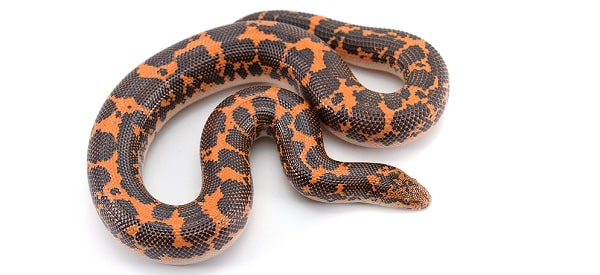
Prevention is the best medicine.
First and foremost, to avoid any unnecessary diseases and illnesses, it’s a good idea to do the following:
- Spot clean waste as soon as you see it
- Wash the water dish at least once a week
- Do a full cage clean every month
A full cage clean involves changing all of the substrate, washing the inside of the enclosure, and washing all enclosure decorations.
Shedding Issues (Dehydration)
As mentioned previously, dehydration is a common issue in Kenyan Sand Boas because they don’t typically drink enough water on their own.
Their instinct is to burrow deep into the earth to access moisture and absorb it through their skin.
Some keepers have had success resolving this issue by crafting a humid hide filled with moist medium, but not all Kenyan Sand Boas catch onto the fact that they need to come above ground to access moisture.
In that case, the best solution is to use a natural, soil-like substrate that you can water periodically. The top layer of soil will dry out, while the moisture will collect in the bottom layer.
Signs of dehydration in Kenyan Sand Boas include:
- Shedding in pieces
- Pieces of shed skin stuck on the snake
- Wrinkles in the skin
Dehydration is not good for the health and longevity of any animal. It is especially taxing on the organs.
Even a stuck shed can cause constrictions and other life-threatening issues.
Respiratory Illness
Respiratory illness is typically caused by excessively high humidity or prolonged exposure to low temperatures.
Respiratory diseases will need to be diagnosed and treated by a veterinarian, typically with an injection of antibiotics every 3 days.
Symptoms of respiratory illness include:
- Open-mouth breathing
- Excessive saliva and mucous production
- Audibly clicking or wheezing while breathing
Scale Rot and Mouth Rot
Scale rot and mouth rot may also be caused by excessive humidity in the enclosure, combined with poor cage hygiene that allows the build-up of dangerous bacteria and fungus.
Scale rot and mouth rot need to be diagnosed and treated by a veterinarian. Injectable antibiotics and topical creams are common treatment choices.
Scale rot presents as dark brown or black lesions, usually on or near the snake’s belly.
Mouth rot presents as:
- Mouth gaping
- Mucous production
- Discoloration near the snake’s lips
Mites
Mite infestation is a common malady for any captive snake.
Mites may be carried in on live feeder rodents, new substrate, or even your skin or clothes if you’ve handled an afflicted snake and then come home.
Most pet retailers carry products explicitly targeted to treating snake and reptile mites.
Frequent shedding and soaking are commonly associated with mite infestations. Healthy Kenyan Sand Boas rarely attempt to soak their bodies.
Kenyan Sand Boa Handling & Bonding
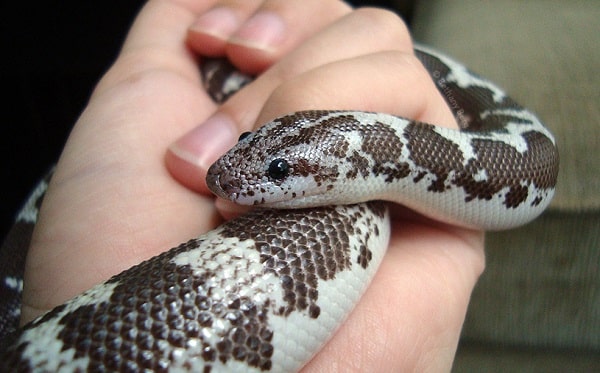
Being terrestrial and semi-fossorial, Kenyan Sand Boas aren’t very good at balancing or using their tails to anchor themselves.
When removing your Kenyan Sand Boa from the enclosure, you should sift your fingers from the bottom of the substrate to the surface, gently lifting their body from underneath.
Once they’re comfortable with their surroundings and with your presence, Kenyan Sand Boas make fun, unique, and interactive pets that don’t mind being handled.
All in all, if you find boa constrictors fascinating, then you’ll probably enjoy our red tail boa care sheet and Brazilian rainbow boa guide as well!
